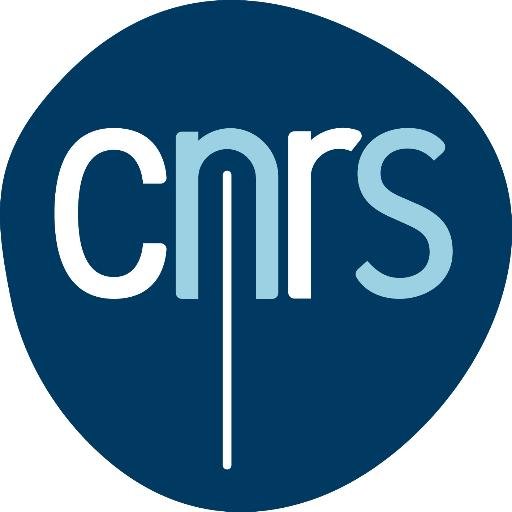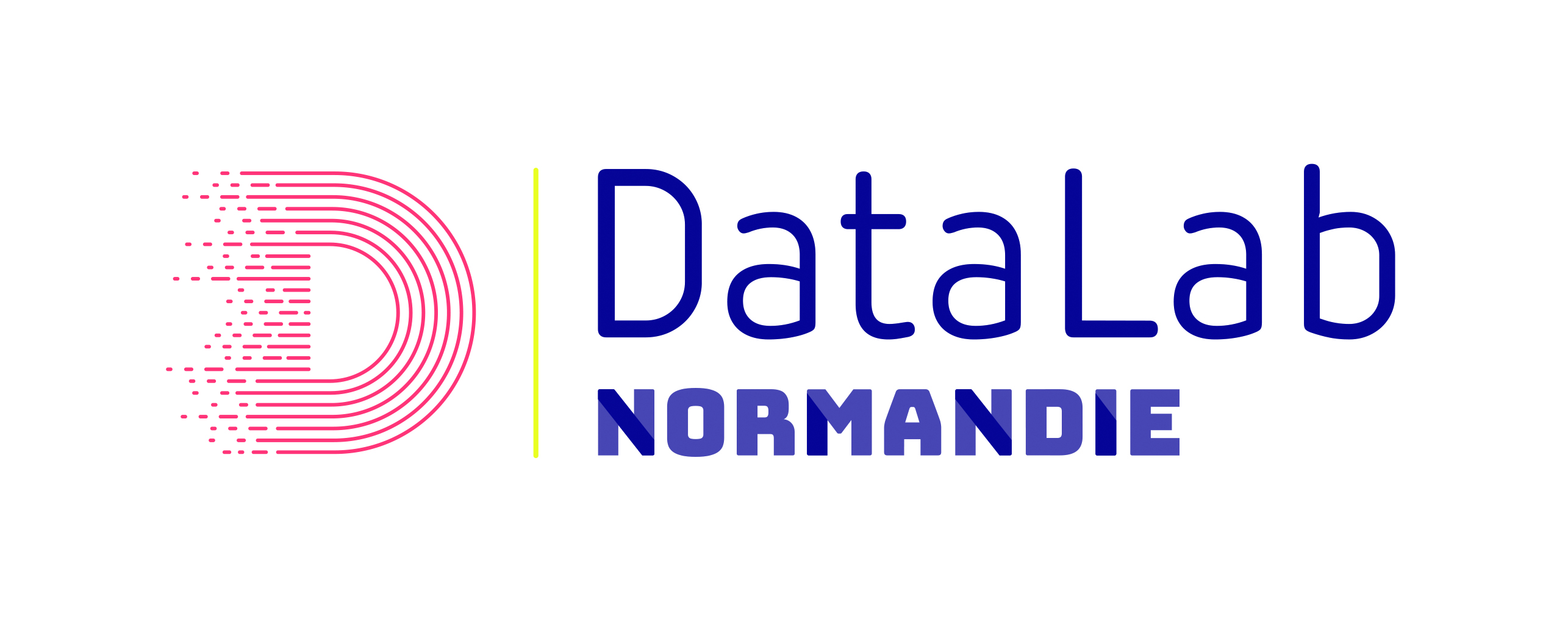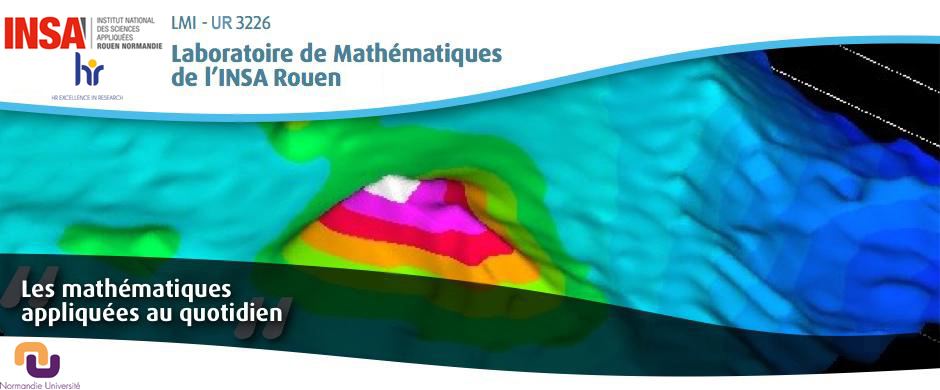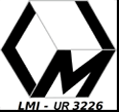- Les 28 et 29 septembre, le LMI sera présent au salon Big Data à Paris avec le Datalab Normandie avec des entreprises normandes et d'autres acteurs académiques.
- Le 30 septembre : journée IA - applications et défis mathématiques dans le cadre du :
Cycle de journées nationales [AMIES, INSMI] :
"Intelligence Artificielle & Entreprises - Applications et défis mathématiques"
30 septembre 2021 - ROUEN INSA
Campus Rouen Madrillet - Amphi CORIA (plan)
Les inscriptions (présentiel) sont closes
(LE PASSE SANITAIRE SERA APPLIQUÉ)
  |
|
| |
 |
Inscription Liste des conférenciers Programme Contact
En collaboration avec l'AMIES, le laboratoire de Mathématiques de INSA Rouen organise une journée thématique sur le thème de l'Intelligence Artficielle
Location & Inscription
INSA Rouen Normandie, 675 Avenue de l'Université 76800 Saint-Etienne-du-Rouvray
Les inscriptions sont closes - Lien ZOOM >>>>>>
Pour les inscrits en présentiel : l'accès à l’évènement sera conditionné par la présentation d'un passe sanitaire valide.
Conférenciers invités
- Stéphanie Allassonière (Université de Paris & PR[AI]RIE)
- Jalal Fadili (ENSICAEN & CNRS)
- Alexandre Gramfort (Inria & Univ. Paris Saclay)
- Ioana Manolescu (Inria et Institut Polytechnique de Paris)
- Christophe Prieur (CNRS, Gipsa-Lab)
- Alain Rakotomamonjy (Criteo AI Lab)
Comité scientifique & Contacts
- Nicolas Forcadel
- Christian Gout
- Hasnaa Zidani
et Merci à A. Cessou, G. Khayretdinova, A. Poux et au CORIA pour l'accueil!...
Pour contacter un membre du comité (Prenom Nom): Cette adresse e-mail est protégée contre les robots spammeurs. Vous devez activer le JavaScript pour la visualiser.
Programme
09:00 - 09:45 Accueil des participants - CORIA (plan) [passe sanitaire obligatoire - Inscriptions closes, si vous n'êtes pas inscrits, solution >>> ZOOM]
09:45 - 10:00 Magalie Fredoc (Cnrs-Amies)
10:00 - 10:45 Stéphanie Allassonière (Université de Paris & PR[AI]RIE)
10:45 - 11:15 Pause café
11:15 - 12:00 Jalal Fadili (ENSICAEN & CNRS)
12:00 - 12:45 Alexandre Gramfort (Inria & Univ. Paris Saclay)
Résumés/Abstracts
Geometry-Aware Variational Autoencoders for Medical Data Augmentation.
by Stéphanie Allassonière (Université de Paris & PR[AI]RIE)
Abstract: In this presentation, we present a new method to perform data augmentation in a reliable way in the High Dimensional Low Sample Size (HDLSS) setting using a geometry-Aware variational autoencoder (VAE). Our approach combines a proper latent space modeling of the VAE seen as a Riemannian manifold with a new generation scheme which produces more meaningful samples especially in the context of small data sets which is the most common targeting medical applications. The proposed method is tested through a wide experimental study where its robustness to data sets, classifiers and training samples size is stressed. It is also validated on a medical imaging classification task on the challenging ADNI database where a small number of 3D brain MRIs are considered and augmented using the proposed VAE framework. In each case, the proposed method allows for a significant and reliable gain in the classification metrics.
A dynamical system perspective of optimization in data science.
by Jalal Fadili (ENSICAEN & CNRS)
Abstract: In this talk, I will discuss and introduce deep insight from the dynamical system perspective to understand the convergence guarantees of first-order algorithms involving inertial features for convex optimization in a Hilbert space setting. Such algorithms are widely popular in various areas of data science (data processing, machine learning, inverse problems, etc.).
They can be viewed discrete as time versions of an inertial second-order dynamical system involving different types of dampings (viscous damping, Hessian-driven geometric damping).
The dynamical system perspective offers not only a powerful way to understand the geometry underlying the dynamic, but also offers a versatile framework to obtain fast, scalable and new algorithms enjoying nice convergence guarantees (including fast rates). In addition, this framework encompasses known algorithms and dynamics such as the Nesterov-type accelerated gradient methods, and the introduction of time scale factors makes it possible to further accelerate these algorithms.
The framework also handles non-smooth convex objectives. We report numerical results on structured problems to support these theoretical findings.
Learning to learn on EEG signals: From bilevel optimization to automatic data-augmentation
by Alexandre Gramfort (Inria & Univ. Paris Saclay)
What do the Sources Say? Interweaving Data Sources with the Help of AI for Journalistic Data Integration
by Ioana Manolescu (Inria & Institut Polytechnique de Paris)
Abstract: Professional journalism is of utmost importance nowadays. It is a main feature distinguishing dictatorships from democracies, and a mirror sorely needed by society to look upon itself and understand its functioning. In turn, understanding is necessary for making informed decisions, such as political choices.
With the world turning increasingly digital, journalists need to analyze very large amounts of data, while having no control over the structure, organization, and format of the data. Since 2013, my team has been working to understand data journalism and computational fact-checking use cases, to identify and develop tools adapted for this challenging setting. I will describe our SourcesSay project (2020-2024), in which extremely heterogeneous data sources are integrated as graphs, on top of which journalistic applications can be supported through flexible graph queries. I will explain the data source integration module, the role played by Information Extraction and Entity Disambiguation, as well as novel techniques to explore and simplify these graphs.
This work is joint with Angelos Anadiotis, Oana Balalau, Helena Galhardas, Tayeb Merabti, Emmanuel Pietriga, and many other colleagues. Project Web site: https://sourcessay.inria.fr/
Navigation avec données magnéto-inertielles: de Kalman aux réseaux de neurones
by Christophe Prieur (CNRS & Gipsa-Lab)
Abstract: Dans cet exposé nous aborderons le problème de l'estimation de l'attitude et de la position d'un corps rigide à partir de capteurs magnéto-inertiels miniatures à bas-coût. L'intérêt de cette approche pour la navigation est qu'elle ne nécessite pas de mesures GPS et donc qu'elle peut être exploitée en intérieur par exemple. Ces mesures nécessitent en revanche de résoudre un problème d'observation de l'état avec des mesures partielles, bruitées et biaisées. Nous montrerons comment les inhomogénéités locales du champ magnétique peuvent être exploitées en complément de techniques classiques (s'inspirant en particulier de R. Kalman). Nous montrerons ensuite comment les réseaux de neurones permettent de résoudre la modélisation optimale des capteurs utilisés, et comment ils permettent également d'améliorer les performances de filtres classiques. Nous conclurons cet exposé par des questions ouvertes en particulier sur l'utilisation de l'IA en boucle fermée avec des systèmes dynamiques.
Solving Machine Learning Domain Adaptation problems through Optimal
Transport
by Alain Rakotomamonjy (Criteo AI Lab)
Abstract: In this talk, I will discuss the key role that optimal transport can play within the context of machine learning, as optimal transport (OT) theory provides geometric tools to compare probability measures.
After introducing the basics of OT, I will describe how they can advance the state-of-the art in domain adaptation and representation learning context.
Linked to M2SiNum project, and Chaire COPTI
![]()

M2SINUM is co-funded by the European Union with the European regional development fund (ERDF)
and by the Normandie Regional Council.
COPTI Chaire d'excellence in research program, co-funded by Région Normandie and EU through ERDF program (February 2021 - January 2025)
Le LMI sera présent sur le stand Datalab Normandie au salon BIG DATA de Paris les 28 et 29 septembre.

Zoé Lambert et Hasnaa Zidani seront présentes sur le stand Datalab Normandie.



